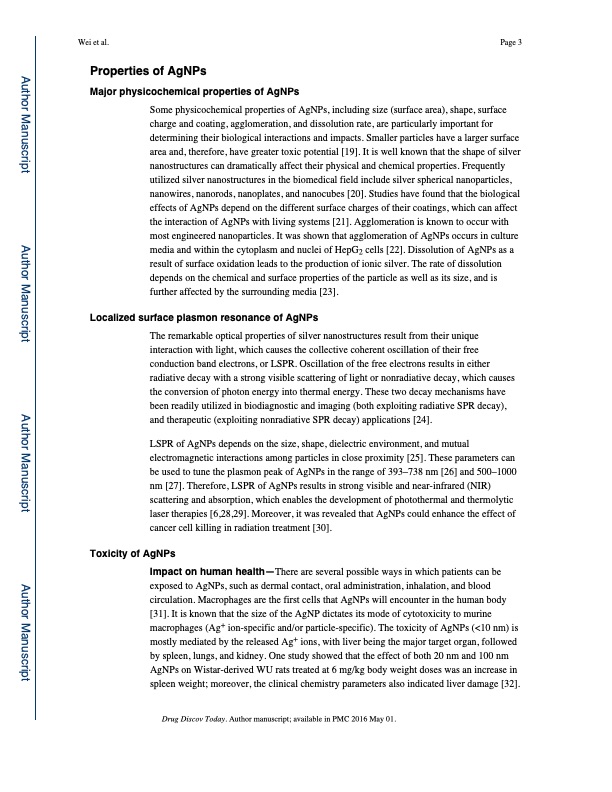
PDF Publication Title:
Text from PDF Page: 003
Wei et al. Page 3 Properties of AgNPs Major physicochemical properties of AgNPs Some physicochemical properties of AgNPs, including size (surface area), shape, surface charge and coating, agglomeration, and dissolution rate, are particularly important for determining their biological interactions and impacts. Smaller particles have a larger surface area and, therefore, have greater toxic potential [19]. It is well known that the shape of silver nanostructures can dramatically affect their physical and chemical properties. Frequently utilized silver nanostructures in the biomedical field include silver spherical nanoparticles, nanowires, nanorods, nanoplates, and nanocubes [20]. Studies have found that the biological effects of AgNPs depend on the different surface charges of their coatings, which can affect the interaction of AgNPs with living systems [21]. Agglomeration is known to occur with most engineered nanoparticles. It was shown that agglomeration of AgNPs occurs in culture media and within the cytoplasm and nuclei of HepG2 cells [22]. Dissolution of AgNPs as a result of surface oxidation leads to the production of ionic silver. The rate of dissolution depends on the chemical and surface properties of the particle as well as its size, and is further affected by the surrounding media [23]. Localized surface plasmon resonance of AgNPs The remarkable optical properties of silver nanostructures result from their unique interaction with light, which causes the collective coherent oscillation of their free conduction band electrons, or LSPR. Oscillation of the free electrons results in either radiative decay with a strong visible scattering of light or nonradiative decay, which causes the conversion of photon energy into thermal energy. These two decay mechanisms have been readily utilized in biodiagnostic and imaging (both exploiting radiative SPR decay), and therapeutic (exploiting nonradiative SPR decay) applications [24]. LSPR of AgNPs depends on the size, shape, dielectric environment, and mutual electromagnetic interactions among particles in close proximity [25]. These parameters can be used to tune the plasmon peak of AgNPs in the range of 393–738 nm [26] and 500–1000 nm [27]. Therefore, LSPR of AgNPs results in strong visible and near-infrared (NIR) scattering and absorption, which enables the development of photothermal and thermolytic laser therapies [6,28,29]. Moreover, it was revealed that AgNPs could enhance the effect of cancer cell killing in radiation treatment [30]. Toxicity of AgNPs Impact on human health—There are several possible ways in which patients can be exposed to AgNPs, such as dermal contact, oral administration, inhalation, and blood circulation. Macrophages are the first cells that AgNPs will encounter in the human body [31]. It is known that the size of the AgNP dictates its mode of cytotoxicity to murine macrophages (Ag+ ion-specific and/or particle-specific). The toxicity of AgNPs (<10 nm) is mostly mediated by the released Ag+ ions, with liver being the major target organ, followed by spleen, lungs, and kidney. One study showed that the effect of both 20 nm and 100 nm AgNPs on Wistar-derived WU rats treated at 6 mg/kg body weight doses was an increase in spleen weight; moreover, the clinical chemistry parameters also indicated liver damage [32]. Drug Discov Today. Author manuscript; available in PMC 2016 May 01. Author Manuscript Author Manuscript Author Manuscript Author ManuscriptPDF Image | Silver nanoparticles: synthesis, properties, therapeutic apps

PDF Search Title:
Silver nanoparticles: synthesis, properties, therapeutic appsOriginal File Name Searched:
nihms651778.pdfDIY PDF Search: Google It | Yahoo | Bing
Turbine and System Plans CAD CAM: Special for this month, any plans are $10,000 for complete Cad/Cam blueprints. License is for one build. Try before you buy a production license. More Info
Waste Heat Power Technology: Organic Rankine Cycle uses waste heat to make electricity, shaft horsepower and cooling. More Info
All Turbine and System Products: Infinity Turbine ORD systems, turbine generator sets, build plans and more to use your waste heat from 30C to 100C. More Info
CO2 Phase Change Demonstrator: CO2 goes supercritical at 30 C. This is a experimental platform which you can use to demonstrate phase change with low heat. Includes integration area for small CO2 turbine, static generator, and more. This can also be used for a GTL Gas to Liquids experimental platform. More Info
Introducing the Infinity Turbine Products Infinity Turbine develops and builds systems for making power from waste heat. It also is working on innovative strategies for storing, making, and deploying energy. More Info
Need Strategy? Use our Consulting and analyst services Infinity Turbine LLC is pleased to announce its consulting and analyst services. We have worked in the renewable energy industry as a researcher, developing sales and markets, along with may inventions and innovations. More Info
Made in USA with Global Energy Millennial Web Engine These pages were made with the Global Energy Web PDF Engine using Filemaker (Claris) software.
Infinity Turbine Developing Spinning Disc Reactor SDR or Spinning Disc Reactors reduce processing time for liquid production of Silver Nanoparticles.
| CONTACT TEL: 608-238-6001 Email: greg@infinityturbine.com | RSS | AMP |